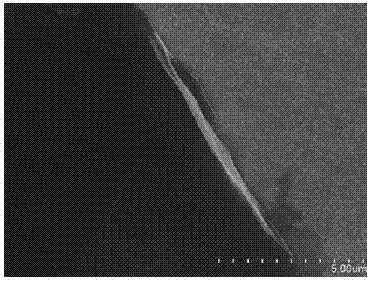Electrochemical immunosensor for measuring melamine content, preparation method and application
An immunosensor, melamine technology, applied in the field of food safety detection and analytical chemistry, to achieve the effect of high sensitivity and specificity, simple detection method and efficient measurement
- Summary
- Abstract
- Description
- Claims
- Application Information
AI Technical Summary
Problems solved by technology
Method used
Image
Examples
Embodiment 1
[0050] Embodiment 1 Immunosensor preparation
[0051] An electrochemical immunosensor for detecting melamine is obtained by modifying a graphene-melamine-chitosan compound on the surface of a glassy carbon electrode.
[0052] Its preparation method is as follows:
[0053] 1) The preparation of graphene mainly uses graphite oxide (GO) as a precursor, and graphene with excellent properties is obtained through the reduction of graphite oxide and the functionalization of graphene.
[0054] Preparation of graphite oxide: 50 mL concentrated H 2 SO 4 +10 g K 2 S 2 o 8 +10 gP 2 o 5 Mixed, 12 g of graphite powder was added to the above mixed solution, and reacted for 6 h. Add 2 L of water and leave overnight. 460 mL concentrated H 2 SO 4 (refrigerator freezing treatment), the oxidized graphite powder was added to the concentrated H 2 SO 4 Stir in. Control the temperature below 10 ℃, slowly add 60 g KMnO 4 , the mixture was reacted at 35 °C for 2 h, 920 mL of deionized wa...
Embodiment 2
[0061] Example 2 Modified electrode cyclic voltammetry scan
[0062] Cyclic voltammetry studies on different modified electrodes, the results are as follows Figure 4 .
[0063] Bare electrode (curve a) at 2 mM K 3 [Fe(CN) 6 ] The cyclic voltammetry curves in solution show a pair of distinct Fe(CN) 6 3- / 4- Redox peak, the oxidation peak current value is 11.1 μA; when only the chitosan solution is modified on the electrode (curve b), the redox peak potential difference becomes wider, and the peak current decreases at the same time, the oxidation peak current value is 9.931 μA, which may It is because the electrochemically inactive chitosan on the electrode surface hinders electron transfer; when the electrode is modified with graphene / melamine / chitosan (curve c), the peak current increases significantly, and the oxidation peak current value is 21.71 μA, the excellent electrochemical activity of graphene greatly enhanced the transfer of electrons; after the graphene / melamin...
Embodiment 3
[0065] Example 3 Detection condition optimization
[0066] The effect of different detection conditions, such as the time of immune response and antibody concentration, was determined by the DPV method.
[0067] 1. Immune response time
[0068] The immunosensor prepared in Example 1 was incubated with the incubation solution containing the same antibody concentration for 0, 10, 20, 40 and 60 minutes, respectively, and then washed with PBS. 3 [Fe(CN) 6 ] solution in a differential pulse voltammetry (DPV) scan, the results are as follows Figure 5 . The DPV peak current of the graphene / melamine / chitosan modified electrode (immunosensor) decreased rapidly within 40 minutes as the incubation time increased, and decreased slightly at 60 minutes ( Figure 5 ). Further increases in incubation time had no apparent effect on the current response. Therefore, 40 min was chosen as the optimal incubation time for the immune response.
[0069] 2. Effect of antibody concentration in i...
PUM
| Property | Measurement | Unit |
|---|---|---|
| Concentration | aaaaa | aaaaa |
Abstract
Description
Claims
Application Information
 Login to View More
Login to View More - R&D
- Intellectual Property
- Life Sciences
- Materials
- Tech Scout
- Unparalleled Data Quality
- Higher Quality Content
- 60% Fewer Hallucinations
Browse by: Latest US Patents, China's latest patents, Technical Efficacy Thesaurus, Application Domain, Technology Topic, Popular Technical Reports.
© 2025 PatSnap. All rights reserved.Legal|Privacy policy|Modern Slavery Act Transparency Statement|Sitemap|About US| Contact US: help@patsnap.com



